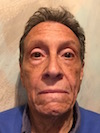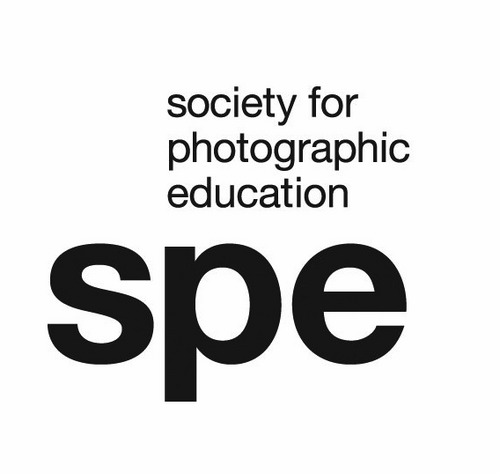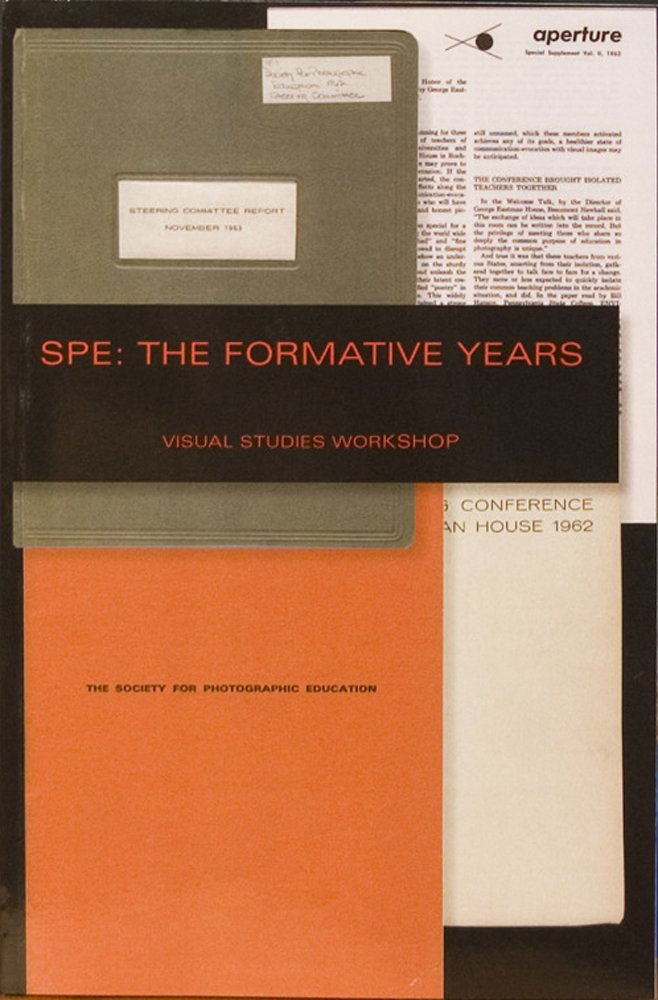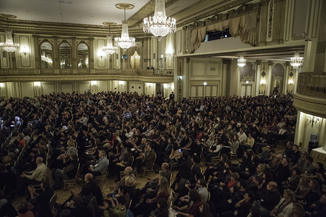 [This review originally appeared on May 28, 2016, commissioned by the now-defunct website Camera Chronicle. While it’s archived at The Wayback Machine, most readers of this blog don’t know how to access it there. So I republish it here to make it more readily accessible, since it’s relevant to my recent posts that involve Nathan Lyons, photo education, and the concept of “visual literacy.”
[This review originally appeared on May 28, 2016, commissioned by the now-defunct website Camera Chronicle. While it’s archived at The Wayback Machine, most readers of this blog don’t know how to access it there. So I republish it here to make it more readily accessible, since it’s relevant to my recent posts that involve Nathan Lyons, photo education, and the concept of “visual literacy.”
As a long-time critic of the Society for Photographic Education — my analyses thereof date back to 1975 — and a long-term member thereof, and now a (probably permanently) lapsed ex-member, I have watched the SPE over the course of almost half a century. That’s the background for this commentary. — A.D.C.]
•
Nathan Lyons, SPE: The Formative Years
With classes over, the academic dust settling, and several thousand new photo BFA and MFA degree holders dumped en masse on the job market in the U.S. alone, what better time than commencement season to ponder the origins of the multi-million-dollar industry that post-secondary photography education has become?
 And what better way to do so than to read what Nathan Lyons calls “the enabling documents” of the 1962 conference from which sprang the Society for Photographic Education (SPE), initially and for some years a professional society and now the largest organization of college-level photo students in the world? Or to watch Jessica S. McDonald — then recently appointed the Nancy Inman and Marlene Nathan Meyerson Curator of Photography at the Harry Ransom Center in Austin, Texas — deliver a keynote talk on that 1962 conference at the SPE Northeast Regional Conference 2012, followed by a panel with McDonald joined by Nathan Lyons and photographer-teacher Kenneth Josephson? Or both?
And what better way to do so than to read what Nathan Lyons calls “the enabling documents” of the 1962 conference from which sprang the Society for Photographic Education (SPE), initially and for some years a professional society and now the largest organization of college-level photo students in the world? Or to watch Jessica S. McDonald — then recently appointed the Nancy Inman and Marlene Nathan Meyerson Curator of Photography at the Harry Ransom Center in Austin, Texas — deliver a keynote talk on that 1962 conference at the SPE Northeast Regional Conference 2012, followed by a panel with McDonald joined by Nathan Lyons and photographer-teacher Kenneth Josephson? Or both?
In addition to Lyons, who called that first conference at George Eastman House in Rochester, New York, and Josephson, the conferees in 1962 included Clarence White, Jr., Aaron Siskind, John Wood, Jerry Uelsmann, Henry Holmes Smith, Walter Rosenblum, and a bunch of others, most of whose names anyone familiar with mid-20th century photography will find familiar. Lyons has gathered those documents together, and the Visual Studies Workshop has made them available in SPE: The Formative Years (Rochester: VSW/SPE, 2012; $20, ISBN: 978-0898221428), a slender softcover volume that should prove of interest to anyone seriously involved in or otherwise concerned with photo education. (To order a copy go to the VSW website.)
Because this book comprises formal documents — papers submitted in advance to the conference, reports summarizing the group’s responses thereto, steering committee proposals for future action, and such — the book has a somewhat formal tone. (Photos of the event, shown in McDonald’s accompanying slides, show the participants dressed in jackets and ties, befitting what they saw as the occasion — or maybe they had a dress code back then.) But not by any means pedantic. Though they had all grounded themselves in the history of photography (as it was then understood), and such related disciplines as visual communication, media theory, and perceptual psychology, these pioneers — most of them teaching artists — wore that learning lightly, writing (and, presumably, speaking) colloquially, with a minimum of anything resembling jargon or shoptalk.
McDonald’s presentation (45 minutes), and the dialogue that she engaged in with Lyons and Josephson immediately thereafter (1 hour), prove equally accessible, adding details and filling in a number of gaps. If you prefer your input in oral/aural form, these provide a basic introduction to the subject. (She also reveals that audiotapes of all the 1962 conference sessions survive in the GEH archive.)
In their pedagogical relation to the medium the conferees all had interdisciplinary yearnings, though perhaps insufficient experience with the territorial imperatives of academe to recognize the futility of attempting long-term multi-departmental collaboration. (In 1969 Lyons would leave GEH to found VSW, in part for that reason.) Yet their vision of teaching photography as not only a craft, and one with a capacity for the poetic, but as a complex communication system with immeasurable power in culture and connections to just about every field of thought, did eventually materialize in some form within the photo-ed system as we know it today — perhaps this cohort’s most enduring legacy, above and beyond the specific academic programs they founded or expanded.
•
Reading through this collection of individual and group statements, it becomes clear that SPE’s founders saw SPE as a professional organization. Membership beyond the initial invitees required recommendation by other members. No students participated in the first conference; this gathering emerged from a felt need on the parts of post-secondary photo teachers — at that time a small cluster of stalwarts, most of them marginalized within their institutions — for intimate, intense dialogue with their colleagues.
None of them expressed concern over the absence of students from their sessions. Certainly they could not have imagined that, half a century later, photo faculty at colleges, universities, and art institutes throughout North America would have contractual obligations to chaperone gaggles of students through the national conferences of an organization the majority of whose membership would consist of students. I suspect they find it disheartening to know that, for all their efforts to create one, no organization today enables teachers of photography to meet and talk with each other without crowds of students around.
In the half-century of its existence SPE transmogrified itself from its original form as an unofficial, photo-specific splinter division of the College Art Association into something akin to photography’s equivalent of the Audubon Society: $20 plus an interest in birds gets you in — and they’ll waive the interest in birds. Speaking as one who maintained SPE membership for many years, functioned as a goad within it, served on the organization’s board of directors, chaired one of its committees, received a lifetime achievement award from it, and wrote about it frequently, I consider its current state a devolution. (The vast majority of its current members disagree — or, even if they agree, either don’t care or actually approve.)
It will require another, much longer book to track just how SPE got from where it started to where it is today. The book at hand, by design, annotates only its origins. Yet it asks, implicitly, what would have happened if the founders had not opened the doors to student membership circa 1968 but instead had hewed closely to their original vision of SPE as a support system for photo teachers and others with an educational relationship to the medium: curators, conservators, historians, critics, theorists. If someone started such an organization today, would it find a constituency to serve?
Lyons has thoughtfully included useful appendices, such as an early membership survey and a 1966 membership list. My only complaint about the book concerns the inept proofreading it received. The frequent typographic errors scattered throughout make it hard to know whether its editor replicated mistakes present in the original materials (for the sake of historical accuracy) or simply couldn’t bother to clean up the texts once digitized.
•
The book does solve an enduring mystery that has long puzzled me: Where did the ungrammaticism embedded in the term “photographic education” come from?
The standard definitions explain the use of the adjective photographic thus:
1. Of, relating to, or consisting of photography or a photograph.
2. Used in photography: a photographic lens.
3. Resembling a photograph, especially representing or simulating something with great accuracy and fidelity of detail.
4. Capable of retaining accurate or vivid impressions: a photographic memory.
No matter how hard and long you study photography and how well you do in your courses, even graduating cum laude will not make your education light-sensitive. When you get a degree as a teacher of art or music, your degree is in “art education” or “music education,” not “artistic education” or “musical education.” In these situations we specify the discipline by using a second noun (art, music, photography) to modify and particularize the more general noun (education).
The fact that our ears have become habituated to this awkward locution simply shows us how careless usage, when allowed to go unchecked, seeps in and degrades the language. To be resisted as much as possible, by my lights, even when that means pissing in the wind by going against the familiar but mistaken usage. Because he started all this, and variants of that usage (including “photographic educators” and “photographic instruction”) appear in his introduction to this volume as well as on its back cover, I feel confident in attributing this to none other than Lyons himself. Now we’re stuck with it, just as we’re stuck with SPE in its current incarnation.
•
Special offer: If you want me to either continue pursuing a particular subject or give you a break and (for one post) write on a topic — my choice — other than the current main story, make a donation of $50 via the PayPal widget below, indicating your preference in a note accompanying your donation. I’ll credit you as that new post’s sponsor, and link to a website of your choosing.
 Include a note with your snail-mail address (or email it to me separately) and I’ll include three (3!) copies of The Silent Strength of Liu Xia, the catalog of the 2012-13 touring exhibition of photos by the dissident Chinese photographer, artist, and poet, who, after eight years of extralegal house arrest in Beijing, finally got released and expatriated to Germany in 2018. The only publication of her photographic work, it includes all 26 images in the exhibition, plus another 14 from the same series, along with essays by Guy Sorman, Andrew Nathan, and Cui Weiping, professor at the Beijing Film Academy. Keep one for yourself, share the others with friends.
Include a note with your snail-mail address (or email it to me separately) and I’ll include three (3!) copies of The Silent Strength of Liu Xia, the catalog of the 2012-13 touring exhibition of photos by the dissident Chinese photographer, artist, and poet, who, after eight years of extralegal house arrest in Beijing, finally got released and expatriated to Germany in 2018. The only publication of her photographic work, it includes all 26 images in the exhibition, plus another 14 from the same series, along with essays by Guy Sorman, Andrew Nathan, and Cui Weiping, professor at the Beijing Film Academy. Keep one for yourself, share the others with friends.








“had hewed closely to their original vision of SPE as a support system for photo teachers and others with an educational relationship to the medium: curators, conservators, historians, critics, theorists. If someone started such an organization today, would it find a constituency to serve?”
Either “no full-time students” or “by invitation only,” if desired, should be sufficient for certain meetings?
Re: “photographic,” perhaps instead a seemingly minor but positive contribution by Nathan Lyons.
In an inter-disciplinary academic context, with the fight to have photography recognized as more than just an adjunct of the A-V department often accomplished, and professional recognition as integral to other media (e.g.Installation Art) as well as on its own, including “found” and “appropriated” photographs, Nathan’s adjectival usage would seem to be quite prescient.
I fail to see how the ungrammatical misuse of the adjectival form of the word “photography” would assist in establishing the medium as worthy of academic respect. To the contrary, calling for more post-secondary emphasis on “musical education” or attention to “artistic education” would strike me as a recipe for getting laughed at rather than taken seriously.
The above reminds me of what a privilege it was to get a BFA in photography in 1954 with teachers such as Clarence White Junior and Walt Alan (a pupil of Moholy-Nagy a Harry Callahan). It was the foundation for the photojournalism program I created that was accredited twenty years later.
In later years the Visual Communication Division of the AEJMC actually served more to the point than SPE. [Editor’s note: “The Association for Education in Journalism and Mass Communication (AEJMC) is a nonprofit, educational association of journalism and mass communication educators, students and media professionals.”]
My program required art design, art history, and history of photography, a subject that did not exist when I was in school. Beaumont Newhall told me how his request to teach it in Rochester was denied because it was not a proper academic subject. Helmut Gernsheim (with whom I was able to spend hours learning the history) had trouble for years trying to give away his massive collection of early history of photography materials. McDonald is now responsible for collection.
In my early years of teaching I had to watch American Studies walk away with the serious discussion of photography as a medium. On symposiums over the years I had to stand up for the point that “fine art” was not the only worthy use of it.
Thanks for this footnote. You’re surely referring to the program you founded at the University of Texas Austin, where the Gernsheim Collection now resides in the Ransom Center.
The Society for Photographic Education has always had an uneasy relationship not only to pre-K-12 photo education but to any form of applied (for which read: other than fine-art-oriented) post-secondary photo ed.
Indeed, sometime in the early ’70s they actually debated dropping “education” from the name, making it simply the “Society for Photography” — definitely the equivalent of the Audubon Society. They didn’t go that far, but, with the approval of a majority of the membership, they added the phrase “especially as it concerns photography as art” to the SPE’s mission statement. (I’m quoting from memory, so I may not have the wording exactly right.)
That had the immediate, implicit effect of marginalizing within SPE not just photojournalism programs but programs — indeed, entire schools (such as the late Brooks Institute) — that emphasized scientific and medical photography, architectural photography, commercial photography. The kinds of programs and schools to which minorities often gravitate, because they can’t afford to study a discipline that graduates them with no employment prospects. So that decision, made by a bunch of white liberals, had an unconscious racial bias.
Thus, instead of an open embrace of all involved in photo ed at all levels, and in all fields, making common cause with all disciplines, SPE’s directorship and membership steadily and deliberately narrowed the organization’s focus to make it exclusively concerned with post-secondary fine-art/creative photography. As far as I know, the organization has never attempted serious outreach to other organizations in parallel areas, such as the AEJMC.